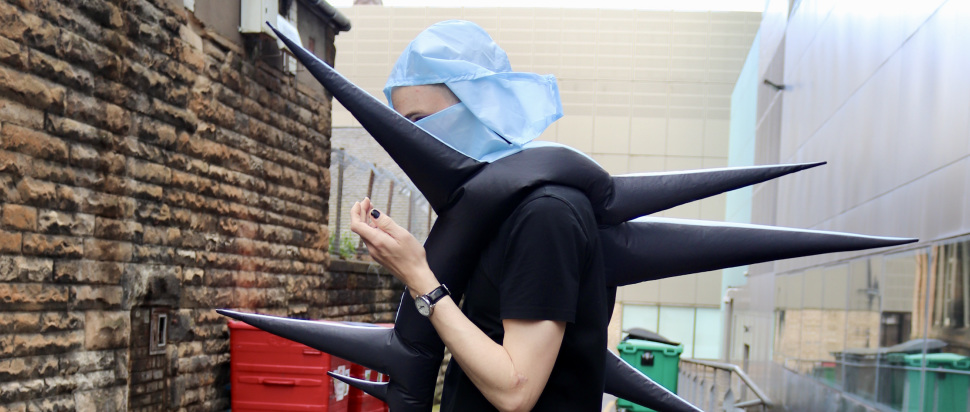GSA Degree Show 2023: Innovation School
With topics ranging from contraception to designing new ways of creating a cultural connection, the fourth-year exhibition from GSA's Product Design students provides a glimpse into the future of design
The fourth-year Product Design Degree Show is an outstanding display of the best and brightest in product design. These graduates demonstrate a fiery commitment to solving real-world problems with design, using their practices to rebel against the myriad challenges to our freedom in the past few years and the obstacles facing us in the future.
Whether for Scottish independence or against the coronation, many people (maybe even you) have involved themselves in protests this year, often facing resistance from police forces in the process. Doug Kennedy responds to the needs of protesters with his project Design for Disobedience. A spiked black wearable, the project aims to increase participation in acts of civil disobedience. Through his work, Doug hopes to draw attention to the ongoing suppression of citizens' rights and freedoms and emphasize the need for as many people as possible to take part in activism, protest and democracy.
The number of people living with chronic illnesses is expected to be more than one in five by 2030, so Nilanjana Mannarprayil has created a speculative experience for dealing with uncertainty and enhancing methods of giving care. By observing people's home environments and conducting interviews, Nilanjana discovered that support systems dwindle with age. Nilanjana sees it as time for society to leave the Get Well Soon! card behind and learn how to provide proper care, so the product Looped In helps people communicate how they would feel cared for, whether that’s by picking up a prescription or grocery shopping. Less-clinical packaging for prescriptions and customisable care stickers enhance this concept by making care personal. By changing these rituals around providing care, people can begin to care for their chronically ill friends and loved ones in a truly helpful way.
Rebecca Lee’s project, ComeAround5, is a shared Chinese cultural sampling experience which aims to build stronger relationships with food through multi-sensory experimentation. The dining experience pushes for authenticity and does this through the sensorial connection of individual ingredients to final assembled meals. In this experience, a chef cooks a traditional Chinese meal for the diners but doesn't reveal what he's cooking. Instead, he presents the main herbs, spices and sauces as experimental samples that look nothing like their original form, leaving diners to use their senses to deduce what the meal is before it even arrives.
As social globalisation increases, linguistic barriers will become more common across social, economic, political and technological sectors. Focused on resolving these barriers, Mio Nevin has created a social design project that uses a game-like format to teach English-speaking people about Japanese culture. The strategy Mio took with this project is inspired by the ability of children to communicate and connect through play before the use of verbal language. So, learning about another nation’s culture can help people overcome language barriers.
Patrick Sheffield's project helps people focus and concentrate in the workplace. He has designed a focus aid box containing various tools to keep people working. The focus aid kit includes hydration sachets, caffeine drops, oil rollers, glasses with coloured lenses, fidget spinners, a die timer, to-do lists, earplugs, chew stims, focus flashcards and sleep masks, all with the sole purpose of improving focus and productivity in the workplace.
Guo Xintong's project deals with the significant increase in human allergies due to food contamination. Guo imagines a future where humans cooperate with parasites to boost their immune systems. This led to designing Liang Fang, a medical restaurant that incorporates parasites into its menu. The speculative restaurant hopes to allow customers to use parasites to regulate their health in the long-term by providing them with exclusive wellness recipes.
Lexi Wieck’s project, Soundshells, is a sensory extension instrument that can enhance, explore, create and enrich an individual's sonic environment. Acting as acoustic headphones, the Soundshells can create a new and distinct soundscape from the existing one. Unlike traditional headphones, Soundshells can create a unique spatial experience that invites users to engage in a recreational auditory activity rooted in a particular time and place. This creates an aural experience that immerses the listener in the surrounding soundscape. By finding a middle ground between awareness and enjoyment, Soundshells enable users to enjoy a more immersive auditory experience.
Margarida Sabino's project, The Plan.o Experience, focuses on creating a space that allows for easier access to contraception, using a playful brand identity to reduce the stigma around it. Margarida sees contraception as taking care of yourself and your future, so it’s something to be happy about. The project involves a colourful bus that provides high-quality contraception products in public areas in the city to make contraception a non-threatening, joyful topic.
All of these projects are testament to the creativity, innovation, and hard work the students have put into their years at the GSA. We're excited to see where their careers take them, and we know they'll continue to push the boundaries of product design in exciting and unexpected ways.
The Innovation School Degree Show runs 2-11 Jun in the Haldane Building, 24 Hill Street, Glasgow. It is also available to view online at gsashowcase.net
